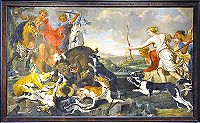 click to enlarge |
THE CALYDONIAN BOAR HUNTJan Fyt & Workshop SN 236, oil on canvas, 1648 From: "The Pages" |
ARTIST:
Jan Fyt, painter, draftsman, and etcher, was born in Antwerp in 1611. After an apprenticeship there, he probably completed his training with Frans Snyders. In 1629-30 he became a master in the Antwerp Guild of St Luke, but continued to work for Snyders until 1631. After spending a year in Paris, he went on to Italy, where he worked for wealthy clients in various cities. By the fall of 1641 he was back in Antwerp, remaining there for the rest of his career, although with occasional travels abroad. He worked in Rubens’ studio as well.
Fyt appeared to have been an avaricious man; his name appears in archives as someone involved in several disputes & lawsuits over money – three of which were against members of his family.
His early work is not known, but must have been fairly close to that of Snyders; then it began to show Italian influence with a tonal palette against a dull background. His approach was emphatic, becoming freer as he developed into one of the most prosperous artists in Antwerp, with good contacts among important collectors & patrons of the period, both local & foreign. His compositions became increasingly daring, but always with balanced asymmetry. He had a tremendous influence on still-life painting in Flanders and the Netherlands as well as Italy.
SUBJECT:
In a typically tragic ancient story, Atalanta was a wild mountain girl (brought up by bears) who was beloved by Meleager, a prince of Calydonia. When Meleager’s father angered Diana (Artemis), goddess of the hunt, she sent a wild boar to terrorize the countryside. As Atalanta was known for her hunting ability as well as devotion to Diana, Meleager enlisted her help in a hunt to kill the beast. Successful, Meleager awarded Atalanta the boar’s skin & head as trophies. This behavior set off a quarrel in his family, bringing Meleager’s ultimate death by fire at the hands of his own mother…. before the horrified eyes of Atalanta.
PAINTING:
This painting demonstrates the complicated studio practice of the time. Although it is signed & dated by Jan Fyt in 1648, it is the work of more than one artist. It shows an archetypal fusion of classical & High Baroque, and the levels of quality possible within a single canvas.
Fyt was one of many artists in Rubens’ studio who sometimes collaborated with the master, and other times worked on his own projects. He was best known for scenes such as the one we see here: a tangle of dogs attacking a terrified, furious boar. As Fyt’s specialty was animals, the human figures were probably painted by Jan Boeckhorst, another of Rubens’ collaborators. It is also possible that a third hand helped out with the landscape.